Self-Declared Physical Activity Levels and Self-Reported Physical Fitness in a Sample of Italian Adolescents during the COVID-19 Pandemic
Abstract
:1. Introduction
2. Materials and Methods
2.1. Participants
2.2. International Physical Activity Questionnaire Short Form (IPAQ-SF)
2.3. International Fitness Scale (IFIS)
2.4. Procedure
2.5. Statistical Analysis
3. Results
4. Discussion
5. Conclusions
Author Contributions
Funding
Institutional Review Board Statement
Informed Consent Statement
Data Availability Statement
Conflicts of Interest
References
- Eime, R.; Harvey, J.; Charity, M.; Elliott, S.; Drummond, M.; Pankowiak, A.; Westerbeek, H. The impact of COVID-19 restrictions on perceived health and wellbeing of adult Australian sport and physical activity participants. BMC Public Health 2022, 22, 848. [Google Scholar] [CrossRef] [PubMed]
- Mækelæ, M.J.; Reggev, N.; Dutra, N.; Tamayo, R.M.; Silva-Sobrinho, R.A.; Klevjer, K.; Pfuhl, G. Perceived efficacy of COVID-19 restrictions, reactions and their impact on mental health during the early phase of the outbreak in six countries. R. Soc. Open Sci. 2020, 7, 200644. [Google Scholar] [CrossRef] [PubMed]
- Meherali, S.; Punjani, N.; Louie-Poon, S.; Abdul Rahim, K.; Das, J.K.; Salam, R.A.; Lassi, Z.S. Mental Health of Children and Adolescents Amidst COVID-19 and Past Pandemics: A Rapid Systematic Review. Int. J. Environ. Res. Public Health 2021, 18, 3432. [Google Scholar] [CrossRef] [PubMed]
- Ammar, A.; Brach, M.; Trabelsi, K.; Chtourou, H.; Boukhris, O.; Masmoudi, L.; Bouaziz, B.; Bentlage, E.; How, D.; Ahmed, M.; et al. Effects of COVID-19 Home Confinement on Eating Behaviour and Physical Activity: Results of the ECLB-COVID19 International Online Survey. Nutrients 2020, 12, 1583. [Google Scholar] [CrossRef] [PubMed]
- Pellino, V.C.; Lovecchio, N.; Puci, M.V.; Marin, L.; Gatti, A.; Pirazzi, A.; Negri, F.; Ferraro, O.E.; Vandoni, M. Effects of the lockdown period on the mental health of elite athletes during the COVID-19 pandemic: A narrative review. Sport Sci. Health 2022, 1–13. [Google Scholar] [CrossRef]
- Jones, E.A.K.; Mitra, A.K.; Bhuiyan, A.R. Impact of COVID-19 on Mental Health in Adolescents: A Systematic Review. Int. J. Environ. Res. Public Health 2021, 18, 2470. [Google Scholar] [CrossRef]
- Tornaghi, M.; Lovecchio, N.; Vandoni, M.; Chirico, A.; Codella, R. Physical activity levels across COVID-19 outbreak in youngsters of Northwestern Lombardy. J. Sports Med. Phys. Fitness 2021, 61, 971–976. [Google Scholar] [CrossRef]
- Dallolio, L.; Marini, S.; Masini, A.; Toselli, S.; Stagni, R.; Bisi, M.C.; Gori, D.; Tessari, A.; Sansavini, A.; Lanari, M.; et al. The impact of COVID-19 on physical activity behaviour in Italian primary school children: A comparison before and during pandemic considering gender differences. BMC Public Health 2022, 22, 52. [Google Scholar] [CrossRef]
- Robinson, E.; Boyland, E.; Chisholm, A.; Harrold, J.; Maloney, N.G.; Marty, L.; Mead, B.R.; Noonan, R.; Hardman, C.A. Obesity, eating behavior and physical activity during COVID-19 lockdown: A study of UK adults. Appetite 2021, 156, 104853. [Google Scholar] [CrossRef]
- Hallal, P.C.; Andersen, L.B.; Bull, F.C.; Guthold, R.; Haskell, W.; Ekelund, U.; Lancet Physical Activity Series Working Group. Global physical activity levels: Surveillance progress, pitfalls, and prospects. Lancet 2012, 380, 247–257. [Google Scholar] [CrossRef]
- Pietrobelli, A.; Pecoraro, L.; Ferruzzi, A.; Heo, M.; Faith, M.; Zoller, T.; Antoniazzi, F.; Piacentini, G.; Fearnbach, S.N.; Heymsfield, S.B. Effects of COVID-19 Lockdown on Lifestyle Behaviors in Children with Obesity Living in Verona, Italy: A Longitudinal Study. Obesity 2020, 28, 1382–1385. [Google Scholar] [CrossRef] [PubMed]
- Bronikowska, M.; Krzysztoszek, J.; Łopatka, M.; Ludwiczak, M.; Pluta, B. Comparison of Physical Activity Levels in Youths before and during a Pandemic Lockdown. Int. J. Environ. Res. Public Health 2021, 18, 5139. [Google Scholar] [CrossRef] [PubMed]
- Rodríguez-Larrad, A.; Mañas, A.; Labayen, I.; González-Gross, M.; Espin, A.; Aznar, S.; Serrano-Sánchez, J.A.; Vera-Garcia, F.J.; González-Lamuño, D.; Ara, I.; et al. Impact of COVID-19 Confinement on Physical Activity and Sedentary Behaviour in Spanish University Students: Role of Gender. Int. J. Environ. Res. Public Health 2021, 18, 369. [Google Scholar] [CrossRef] [PubMed]
- Lovecchio, N.; Zago, M. Fitness differences according to BMI categories: A new point of view. J. Sports Med. Phys. Fit. 2019, 59, 298–303. [Google Scholar] [CrossRef]
- Lovecchio, N.; Novak, D.; Sedlacek, J.; Hamar, P.; Milanovic, I.; Radisavljevic-Janic, S.; Emeljanovas, A.; Eid, L.; Zago, M. Physical fitness for sedentary students: A common trend from six European countries. J. Sports Med. Phys. Fit. 2019, 59, 1389–1396. [Google Scholar] [CrossRef] [PubMed]
- Pellino, V.C.; Giuriato, M.; Ceccarelli, G.; Codella, R.; Vandoni, M.; Lovecchio, N.; Nevill, A.M. Explosive Strength Modeling in Children: Trends According to Growth and Prediction Equation. Appl. Sci. 2020, 10, 6430. [Google Scholar] [CrossRef]
- Giuriato, M.; Nevill, A.; Kawczynski, A.; Lovecchio, N. Body size and shape characteristics for Cooper’s 12 minutes run test in 11–13 years old Caucasian children: An allometric approach. J. Sports Med. Phys. Fit. 2020, 60, 417–421. [Google Scholar] [CrossRef]
- Giuriato, M.; Codella, R.; Lovecchio, N.; Pellino, V.C.; Vandoni, M.; Nevill, A.M. Speed agility trends in children according to growth. Ann. Hum. Biol. 2021, 48, 271–279. [Google Scholar] [CrossRef]
- Vandoni, M.; Pellino, V.C.; De Silvestri, A.; Lovecchio, N.; Rovida, A.; Gatti, A.; Biagioli, V.; Zuccotti, G.; Calcaterra, V. The Temporal Association between Body Characteristics and Speed Performance over Twenty-Five Years in Italian Adolescents. Children 2022, 9, 521. [Google Scholar] [CrossRef]
- Tarp, J.; Støle, A.P.; Blond, K.; Grøntved, A. Cardiorespiratory fitness, muscular strength and risk of type 2 diabetes: A systematic review and meta-analysis. Diabetologia 2019, 62, 1129–1142. [Google Scholar] [CrossRef] [Green Version]
- Ortega, F.B.; Ruiz, J.R.; Castillo, M.J.; Sjöström, M. Physical fitness in childhood and adolescence: A powerful marker of health. Int. J. Obes. 2008, 32, 1–11. [Google Scholar] [CrossRef] [PubMed] [Green Version]
- Bakker, E.A.; Sui, X.; Brellenthin, A.G.; Lee, D.-C. Physical activity and fitness for the prevention of hypertension. Curr. Opin. Cardiol. 2018, 33, 394–401. [Google Scholar] [CrossRef] [PubMed]
- Kodama, S.; Saito, K.; Tanaka, S.; Maki, M.; Yachi, Y.; Asumi, M.; Sugawara, A.; Totsuka, K.; Shimano, H.; Ohashi, Y.; et al. Cardiorespiratory fitness as a quantitative predictor of all-cause mortality and cardiovascular events in healthy men and women: A meta-analysis. JAMA 2009, 301, 2024–2035. [Google Scholar] [CrossRef] [PubMed] [Green Version]
- Gupta, S.; Rohatgi, A.; Ayers, C.R.; Willis, B.L.; Haskell, W.L.; Khera, A.; Drazner, M.H.; de Lemos, J.A.; Berry, J.D. Cardiorespiratory fitness and classification of risk of cardiovascular disease mortality. Circulation 2011, 123, 1377–1383. [Google Scholar] [CrossRef] [PubMed] [Green Version]
- Ruegsegger, G.; Booth, F.W. Health Benefits of Exercise. Cold Spring Harb. Perspect. Med. 2018, 8, a029694. [Google Scholar] [CrossRef] [PubMed] [Green Version]
- Kokkinos, P.; Myers, J.; Faselis, C.; Panagiotakos, D.B.; Doumas, M.; Pittaras, A.; Manolis, A.; Kokkinos, J.P.; Karasik, P.; Greenberg, M.; et al. Exercise capacity and mortality in older men: A 20-year follow-up study. Circulation 2010, 122, 790–797. [Google Scholar] [CrossRef] [Green Version]
- Ortega, F.B.; Ruiz, J.R.; España-Romero, V.; Vicente-Rodriguez, G.; Martínez-Gómez, D.; Manios, Y.; Béghin, L.; Molnar, D.; Widhalm, K.; A Moreno, L.; et al. The International Fitness Scale (IFIS): Usefulness of self-reported fitness in youth. Int. J. Epidemiol. 2011, 40, 701–711. [Google Scholar] [CrossRef] [Green Version]
- Crocker, P.R.; Eklund, R.C.; Kowalski, K.C. Children’s physical activity and physical self-perceptions. J. Sports Sci. 2000, 18, 383–394. [Google Scholar] [CrossRef]
- Palacios-Cartagena, R.P.; Parraca, J.A.; Mendoza-Muñoz, M.; Pastor-Cisneros, R.; Muñoz-Bermejo, L.; Adsuar, J.C. Level of Physical Activity and Its Relationship to Self-Perceived Physical Fitness in Peruvian Adolescents. Int. J. Environ. Res. Public Health 2022, 19, 1182. [Google Scholar] [CrossRef]
- Makizako, H.; Nakai, Y.; Shiratsuchi, D.; Akanuma, T.; Yokoyama, K.; Matsuzaki-Kihara, Y.; Yoshida, H. Perceived declining physical and cognitive fitness during the COVID-19 state of emergency among community-dwelling Japanese old-old adults. Geriatr. Gerontol. Int. 2021, 21, 364–369. [Google Scholar] [CrossRef]
- JAVA Declaration of Helsinki World Medical Association Declaration of Helsinki. Bull. World Health Organ. 2013, 79, 1–8.
- Mannocci, A.; Di Thiene, D.; Del Cimmuto, A.; Masala, D.; Boccia, A.; De Vito, E.; La Torre, G. International Physical Activity Questionnaire: Validation and assessment in an Italian sample. Int. J. Public Health 2010, 7, 369–376. [Google Scholar] [CrossRef]
- International Physical Activity Questionnaire. Guidelines for Data Processing and Analysis of the International Physical Activity Questionnaire (IPAQ)—Short Form. 2004. Available online: https://sites.google.com/site/theipaq/ (accessed on 31 May 2022).
- Insworth, B.E.; Haskell, W.L.; Whitt, M.C.; Irwin, M.L.; Swartz, A.M.; Strath, S.J.; O’Brien, W.L.; Bassett, D.R., Jr.; Schmitz, K.H.; Emplaincourt, P.O.; et al. Compendium of physical activities: An update of activity codes and MET intensities. Med. Sci. Sports Exerc. 2000, 32 (Suppl. 9), S498–S504. [Google Scholar] [CrossRef] [PubMed] [Green Version]
- Carraro, A.; Young, M.; Robazza, C. A contribution to the validation of the physical activity enjoyment scale in an Italian sample. Soc. Behav. Personal. Int. J. 2008, 36, 911–918. [Google Scholar] [CrossRef]
- Cohen, J. Statistical Power Analysis for the Behavioral Sciences; Taylor & Francis: Oxfordshire, UK, 2013; Available online: https://books.google.it/books?id=cIJH0lR33bgC (accessed on 31 May 2022).
- Altintaş, A.; Aşçi, F.H. Physical self-esteem of adolescents with regard to physical activity and pubertal status. Pediatr. Exerc. Sci. 2008, 20, 142–156. [Google Scholar] [CrossRef]
- Fernandez Alvarez, L.E.; Carriedo, A.; González González de Mesa, C. Relaciones entre el autoconcepto físico, la condición física, la coordinación motriz y la actividad física en estudiantes de secundaria. J. Sport Health Res. 2020, 12, 259–270. [Google Scholar]
- Malete, L.; Sullivan, P.; Matthies, B.K. Examining physical self-perceptions and physical activity of Jamaican youths: A cultural extension of the PSPP. Int. J. Sport Exerc. Psychol. 2008, 6, 39–52. [Google Scholar] [CrossRef]
- Stodden, D.F.; Goodway, J.D.; Langendorfer, S.J.; Roberton, M.A.; Rudisill, M.E.; Garcia, C.; Garcia, L.E. A Developmental Perspective on the Role of Motor Skill Competence in Physical Activity: An Emergent Relationship. Quest 2008, 60, 290–306. [Google Scholar] [CrossRef]
- Inchley, J.; Kirby, J.; Currie, C. Longitudinal changes in physical self-perceptions and associations with physical activity during adolescence. Pediatr. Exerc. Sci. 2011, 23, 237–249. [Google Scholar] [CrossRef] [Green Version]
- Timo, J.; Sami, Y.P.; Anthony, W.; Jarmo, L. Perceived physical competence towards physical activity, and motivation and enjoyment in physical education as longitudinal predictors of adolescents’ self-reported physical activity. J. Sci. Med. Sport 2016, 19, 750–754. [Google Scholar] [CrossRef]
- Gallè, F.; Sabella, E.A.; Ferracuti, S.; De Giglio, O.; Caggiano, G.; Protano, C.; Valeriani, F.; Parisi, E.A.; Valerio, G.; Liguori, G.; et al. Sedentary Behaviors and Physical Activity of Italian Undergraduate Students during Lockdown at the Time of CoViD-19 Pandemic. Int. J. Environ. Res. Public Health 2020, 17, 6171. [Google Scholar] [CrossRef] [PubMed]
- Ruíz-Roso, M.B.; de Carvalho Padilha, P.; Matilla-Escalante, D.C.; Brun, P.; Ulloa, N.; Acevedo-Correa, D.; Ferreira Peres, W.A.; Martorell, M.; Bousquet Carrilho, T.R.; De Oliveira Cardoso, L.; et al. Changes of Physical Activity and Ultra-Processed Food Consumption in Adolescents from Different Countries during COVID-19 Pandemic: An Observational Study. Nutrients 2020, 12, 2289. [Google Scholar] [CrossRef] [PubMed]
- Violant-Holz, V.; Gallego-Jiménez, M.G.; González-González, C.S.; Muñoz-Violant, S.; Rodríguez, M.J.; Sansano-Nadal, O.; Guerra-Balic, M. Psychological Health and Physical Activity Levels during the COVID-19 Pandemic: A Systematic Review. Int. J. Environ. Res. Public Health 2020, 17, 9419. [Google Scholar] [CrossRef] [PubMed]
- Wahid, A.; Manek, N.; Nichols, M.; Kelly, P.; Foster, C.; Webster, P.; Kaur, A.; Smith, C.F.; Wilkins, E.; Rayner, M.; et al. Quantifying the Association Between Physical Activity and Cardiovascular Disease and Diabetes: A Systematic Review and Meta-Analysis. J. Am. Heart Assoc. 2016, 5, e002495. [Google Scholar] [CrossRef] [PubMed] [Green Version]
- Hammami, A.; Harrabi, B.; Mohr, M.; Krustrup, P. Physical activity and coronavirus disease 2019 (COVID-19): Specific recommendations for home-based physical training. Manag. Sport Leis. 2020, 27, 26–31. [Google Scholar] [CrossRef]
- Vandoni, M.; Codella, R.; Pippi, R.; Pellino, V.C.; Lovecchio, N.; Marin, L.; Silvestri, D.; Gatti, A.; Magenes, V.C.; Regalbuto, C.; et al. Combatting Sedentary Behaviors by Delivering Remote Physical Exercise in Children and Adolescents with Obesity in the COVID-19 Era: A Narrative Review. Nutrients 2021, 13, 4459. [Google Scholar] [CrossRef]
- Calcaterra, V.; Verduci, E.; Vandoni, M.; Rossi, V.; Di Profio, E.; Pellino, V.C.; Tranfaglia, V.; Pascuzzi, M.C.; Borsani, B.; Bosetti, A.; et al. Telehealth: A Useful Tool for the Management of Nutrition and Exercise Programs in Pediatric Obesity in the COVID-19 Era. Nutrients 2021, 13, 3689. [Google Scholar] [CrossRef]
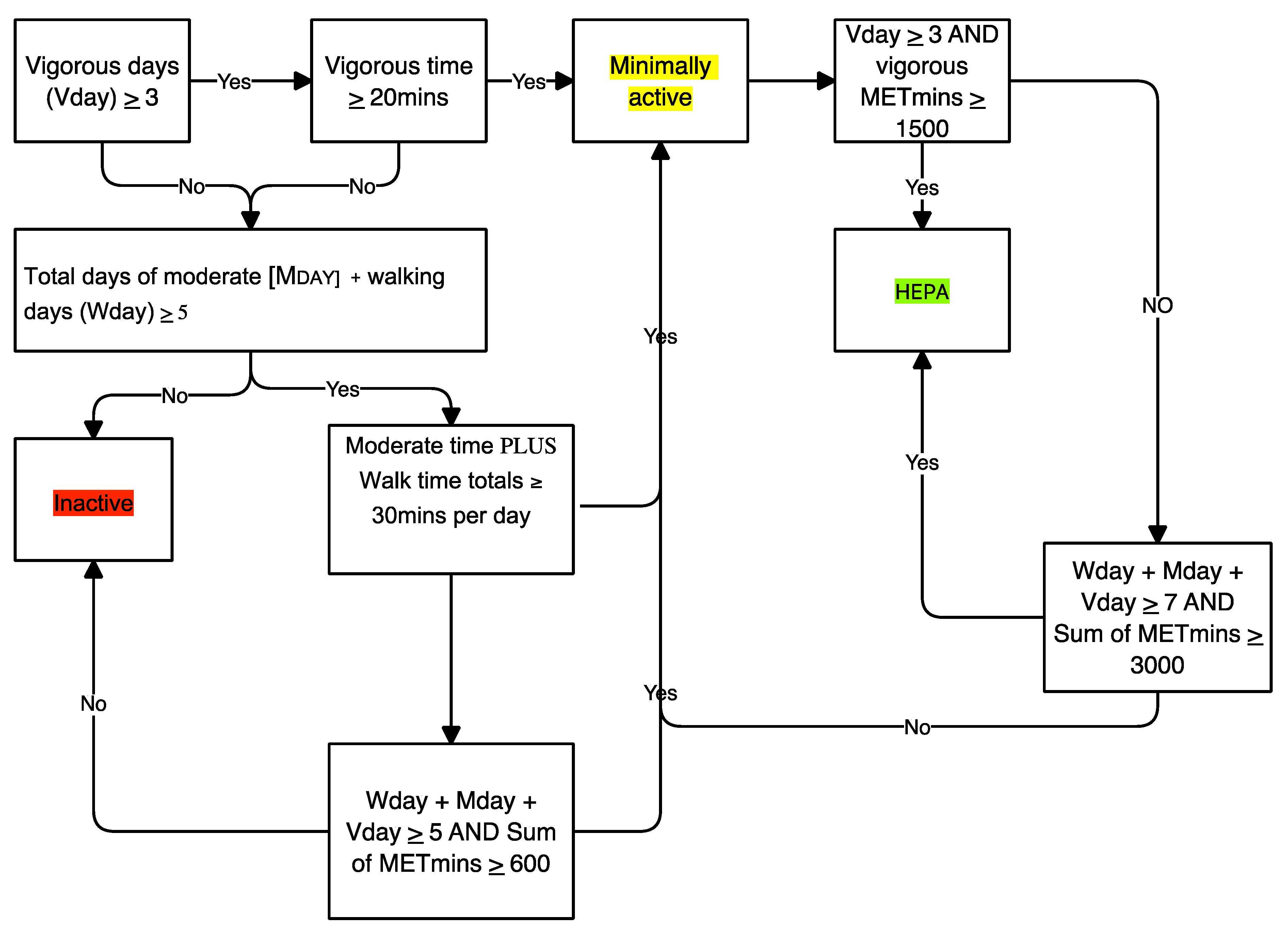
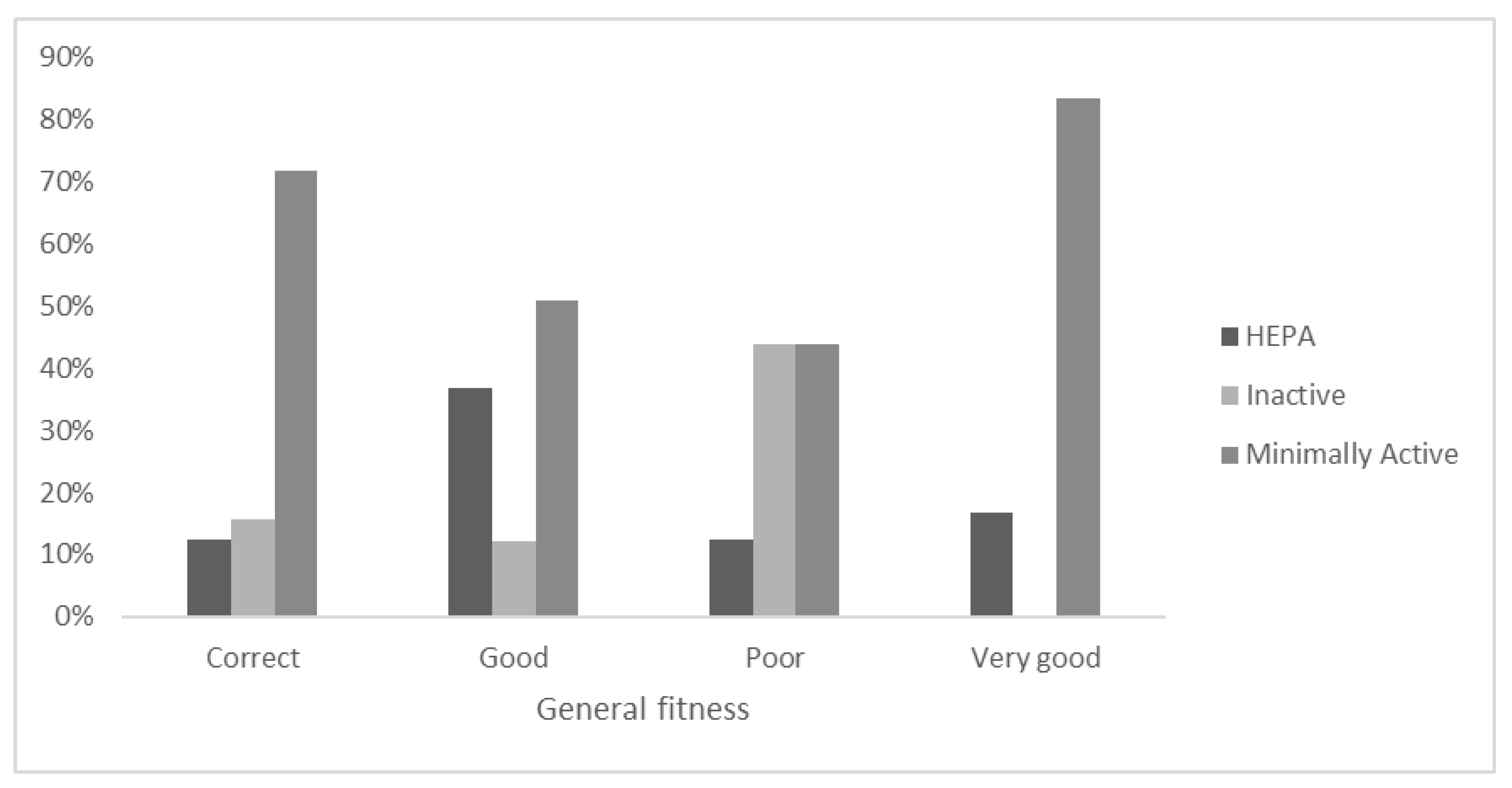
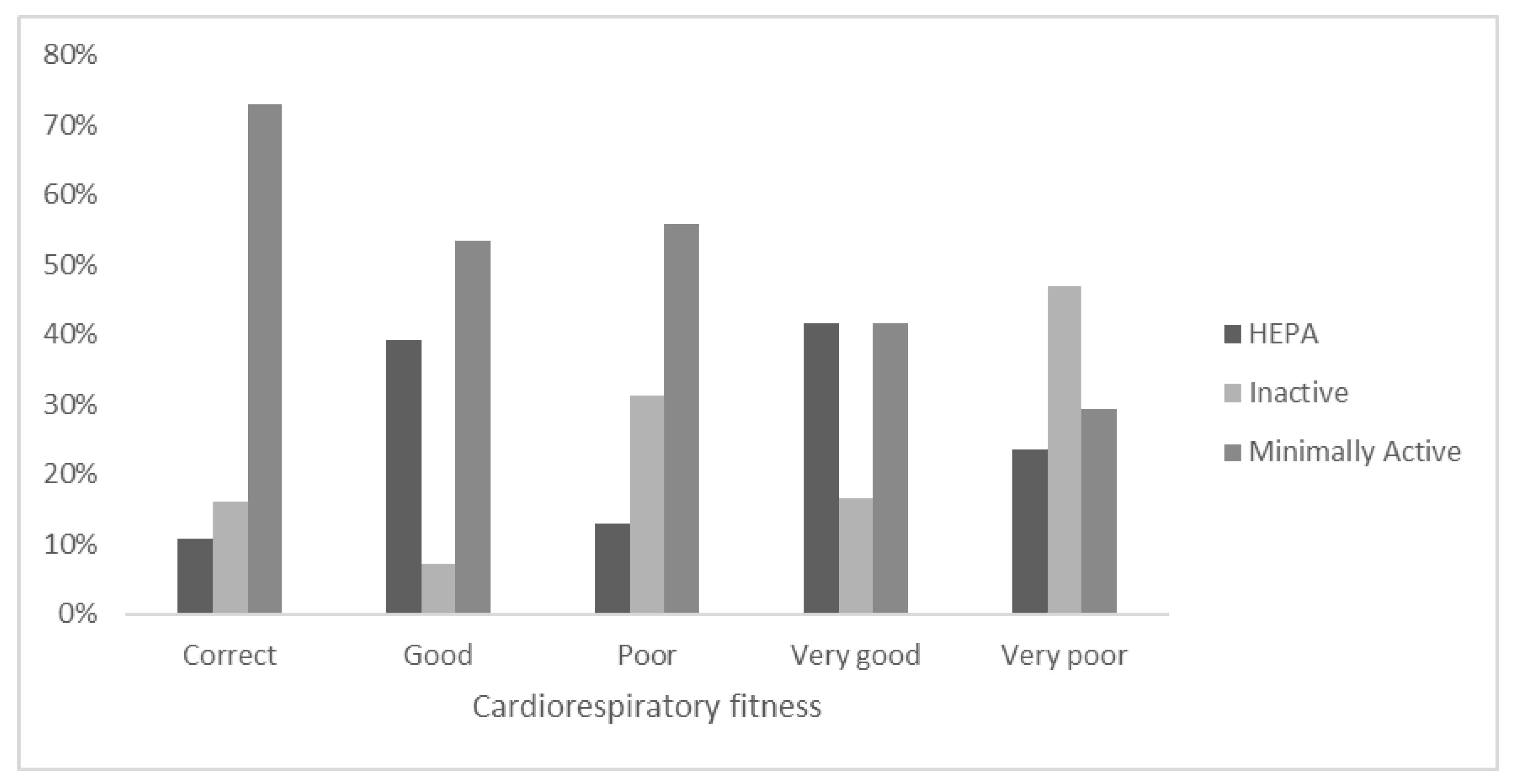
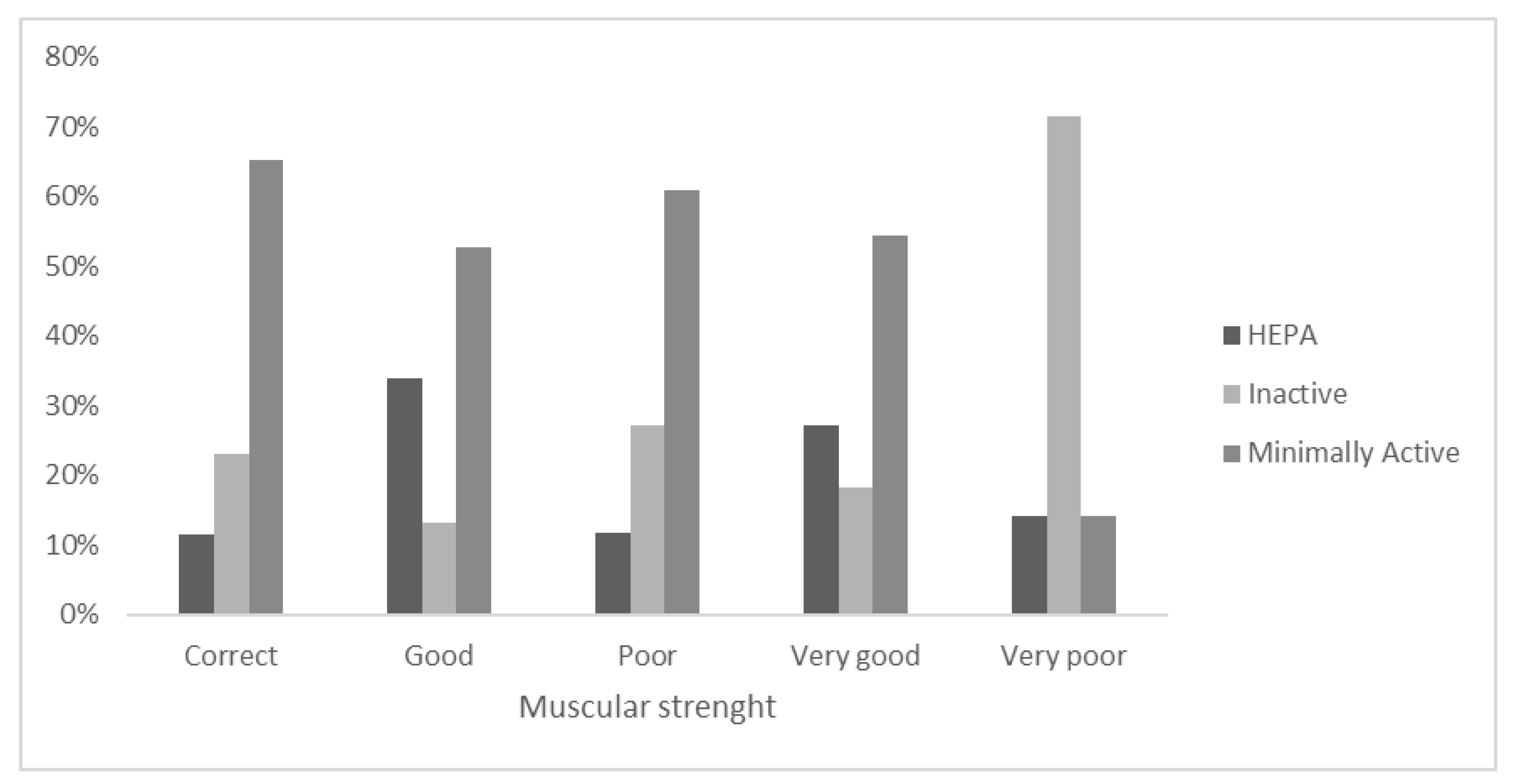
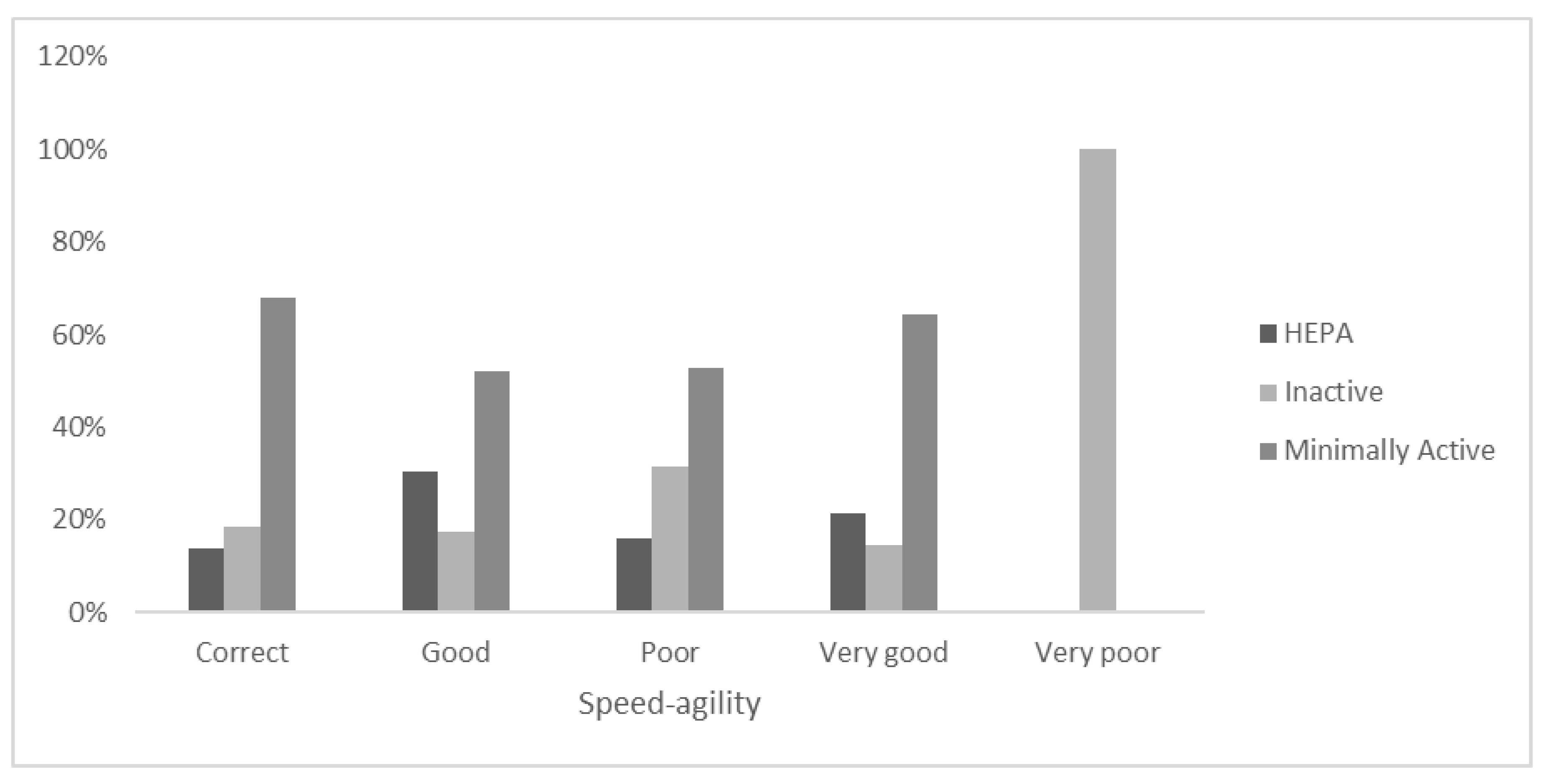
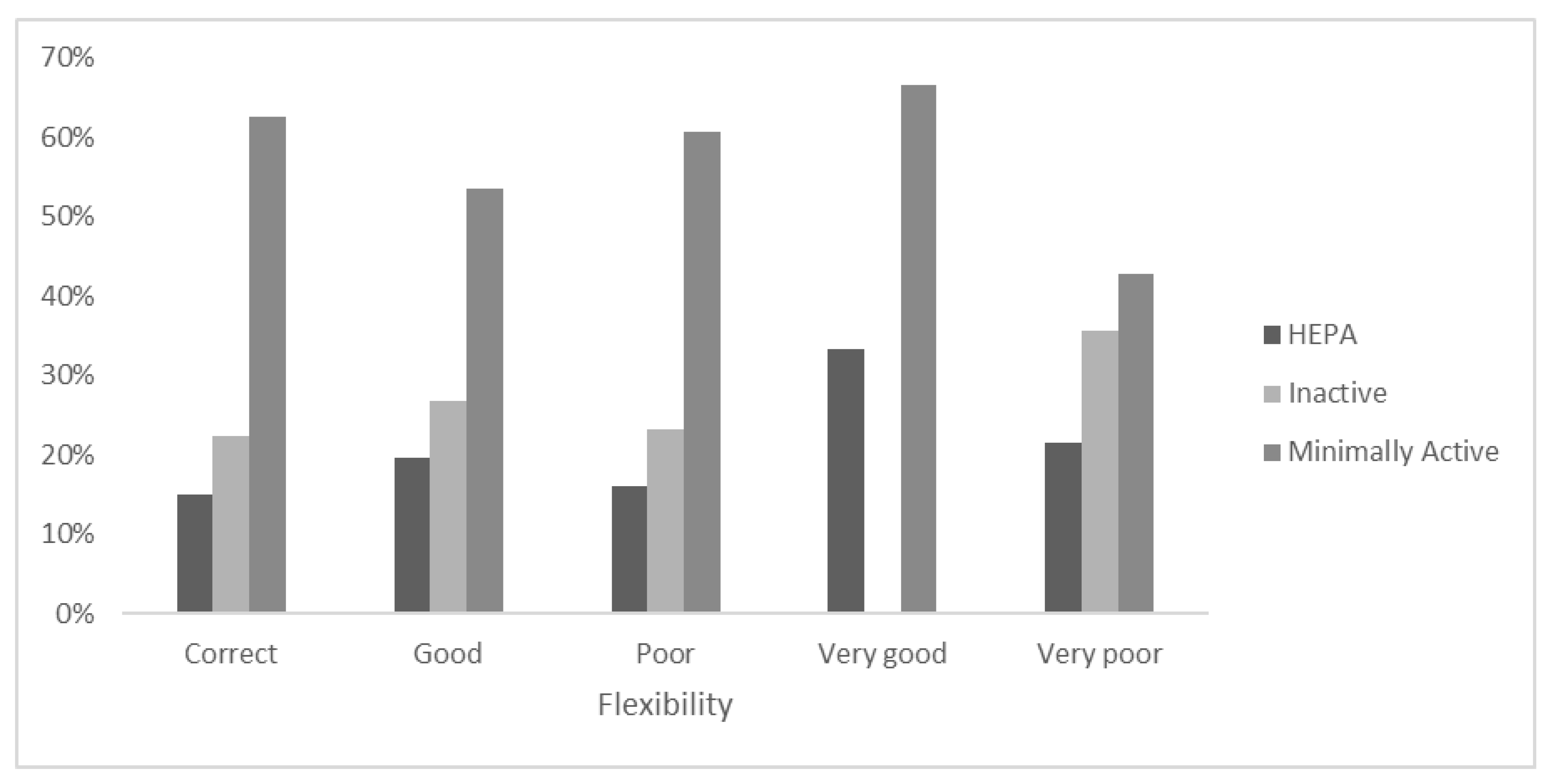
| N | Age (Years) | Height (m) | Weight (kg) | BMI (kg/m2) | |
|---|---|---|---|---|---|
| All the samples | 208 | 16.5 ± 1.5 | 1.6 ± 0.2 | 57.1 ± 10.1 | 20.6 ± 2.9 |
| Boys | 42 | 16.4 ± 3.0 | 1.7 ± 0.3 | 65.2 ± 9.3 | 20.8 ± 2.6 |
| Girls | 166 | 16.4 ± 2.0 | 1.6 ± 0.2 | 54.5 ± 10.5 | 20.4 ± 3.5 |
| Inactive | Minimally Active | HEPA | ||||
|---|---|---|---|---|---|---|
| N | % | N | % | N | % | |
| All the sample | 48 | 23.1% | 122 | 58.6% | 38 | 18.3% |
| Boys | 9 | 21.4% | 27 | 64.3% | 6 | 14.3% |
| Girls | 39 | 23.5% | 95 | 57.2% | 32 | 19.3% |
| Very Poor | Poor | Correct | Good | Very Good | ||||||
|---|---|---|---|---|---|---|---|---|---|---|
| N | % | N | % | N | % | N | % | N | % | |
| General fitness | 0 | 0.0% | 64 | 30.8% | 89 | 42.8% | 49 | 23.6% | 6 | 2.9% |
| Cardiorespiratory fitness | 17 | 8.1% | 77 | 37.0% | 74 | 35.6% | 28 | 13.5% | 12 | 5.8% |
| Muscular strength | 7 | 3.3% | 59 | 28.4% | 78 | 37.5% | 53 | 25.5% | 11 | 5.3% |
| Speed–agility | 4 | 1.9% | 57 | 27.4% | 87 | 41.8% | 46 | 22.1% | 14 | 6.7% |
| Flexibility | 14 | 6.7% | 56 | 26.9% | 67 | 32.2% | 56 | 26.9% | 15 | 7.2% |
| IPAQ-SF | ||
|---|---|---|
| Correlation Coefficient | p-Value | |
| General fitness | 0.323 *** | <0.001 |
| Cardiorespiratory fitness | 0.258 *** | <0.001 |
| Muscular strength | 0.239 *** | <0.001 |
| Speed–agility | 0.205 ** | 0.003 |
| Flexibility | 0.089 | 0.203 |
Publisher’s Note: MDPI stays neutral with regard to jurisdictional claims in published maps and institutional affiliations. |
© 2022 by the authors. Licensee MDPI, Basel, Switzerland. This article is an open access article distributed under the terms and conditions of the Creative Commons Attribution (CC BY) license (https://creativecommons.org/licenses/by/4.0/).
Share and Cite
Gatti, A.; Pugliese, L.; Carnevale Pellino, V.; Del Bianco, M.; Vandoni, M.; Lovecchio, N. Self-Declared Physical Activity Levels and Self-Reported Physical Fitness in a Sample of Italian Adolescents during the COVID-19 Pandemic. Eur. J. Investig. Health Psychol. Educ. 2022, 12, 655-665. https://doi.org/10.3390/ejihpe12060049
Gatti A, Pugliese L, Carnevale Pellino V, Del Bianco M, Vandoni M, Lovecchio N. Self-Declared Physical Activity Levels and Self-Reported Physical Fitness in a Sample of Italian Adolescents during the COVID-19 Pandemic. European Journal of Investigation in Health, Psychology and Education. 2022; 12(6):655-665. https://doi.org/10.3390/ejihpe12060049
Chicago/Turabian StyleGatti, Alessandro, Lorenzo Pugliese, Vittoria Carnevale Pellino, Marco Del Bianco, Matteo Vandoni, and Nicola Lovecchio. 2022. "Self-Declared Physical Activity Levels and Self-Reported Physical Fitness in a Sample of Italian Adolescents during the COVID-19 Pandemic" European Journal of Investigation in Health, Psychology and Education 12, no. 6: 655-665. https://doi.org/10.3390/ejihpe12060049
APA StyleGatti, A., Pugliese, L., Carnevale Pellino, V., Del Bianco, M., Vandoni, M., & Lovecchio, N. (2022). Self-Declared Physical Activity Levels and Self-Reported Physical Fitness in a Sample of Italian Adolescents during the COVID-19 Pandemic. European Journal of Investigation in Health, Psychology and Education, 12(6), 655-665. https://doi.org/10.3390/ejihpe12060049







